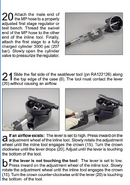Make adjustments of 1/32 to 1/16 turn per adjustment until leakage stops and then another 1/32 to 1/16 turn.
Thanks that worked perfectly! I might have gone a 1/16 total. What happens if I went farther just out of curiosity?
Would require a little more inhalation effort, to crack open valve and let gas into stage.
'Majority of safe second octos are purposely tuned this way.
NO!
This is how DIY can kill you.
@Endler's comment above is true, but apples and oranges.
Turning the second stage orifice in further will drop the lever. It is poorly appreciated how small an adjustment should be made. At depth, (high gas density), a low lever will provide inadequate gas flow and may kill you.
While safe second octos are indeed tuned this way, they are almost all downstream (unbalanced) seconds, where you can raise the lever with the nut, after screwing in the orifice.
The Core is a balanced second.
While a hiss from a worn seat can indeed be fixed with a TINY orifice adjustment, anything beyond 1/6 turn after the reg seals will visibly drop the lever. And a scratched knife edge cannot be adjusted with a proper lever height. It takes too much pressure on the seat to seal.
To the lurkers reading this thread. Please don't tune your leaking gear from an Internet post.
And if you think having the Service Manual will eliminate the "no formal training" problem, read this tuning instruction from the Dive Rite XT2 manual.
"Using the second stage adjusting tool set the resistance to .8-1.0 inches of water."
That's all it says. "Just keep turning the orifice in until you get 1 inch." WRONG!
If you haven't been trained, get someone who has, to help you.
Kudos to
@Scoooter961 for not thinking, "if a little is good, more must be better", and for asking questions!





